英语倒装句(最全面_最简洁)
- 格式:doc
- 大小:49.50 KB
- 文档页数:4
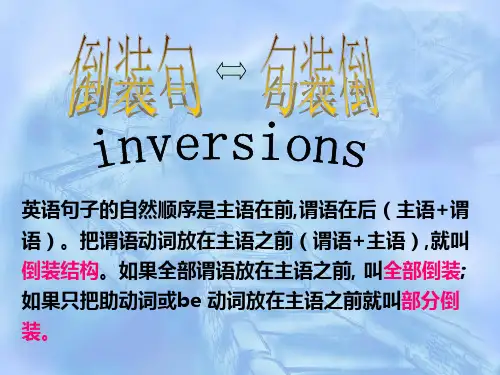
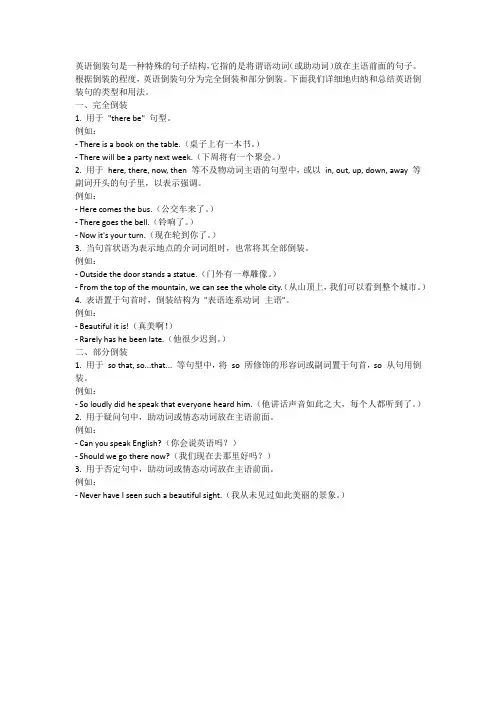
英语倒装句是一种特殊的句子结构,它指的是将谓语动词(或助动词)放在主语前面的句子。
根据倒装的程度,英语倒装句分为完全倒装和部分倒装。
下面我们详细地归纳和总结英语倒装句的类型和用法。
一、完全倒装1. 用于"there be" 句型。
例如:- There is a book on the table.(桌子上有一本书。
)- There will be a party next week.(下周将有一个聚会。
)2. 用于here, there, now, then 等不及物动词主语的句型中,或以in, out, up, down, away 等副词开头的句子里,以表示强调。
例如:- Here comes the bus.(公交车来了。
)- There goes the bell.(铃响了。
)- Now it's your turn.(现在轮到你了。
)3. 当句首状语为表示地点的介词词组时,也常将其全部倒装。
例如:- Outside the door stands a statue.(门外有一尊雕像。
)- From the top of the mountain, we can see the whole city.(从山顶上,我们可以看到整个城市。
)4. 表语置于句首时,倒装结构为"表语连系动词主语"。
例如:- Beautiful it is!(真美啊!)- Rarely has he been late.(他很少迟到。
)二、部分倒装1. 用于so that, so...that... 等句型中,将so 所修饰的形容词或副词置于句首,so 从句用倒装。
例如:- So loudly did he speak that everyone heard him.(他讲话声音如此之大,每个人都听到了。
)2. 用于疑问句中,助动词或情态动词放在主语前面。
例如:- Can you speak English?(你会说英语吗?)- Should we go there now?(我们现在去那里好吗?)3. 用于否定句中,助动词或情态动词放在主语前面。
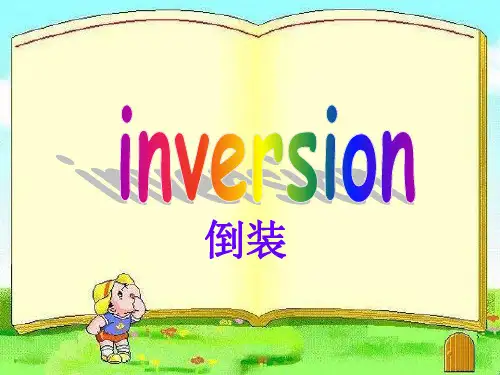
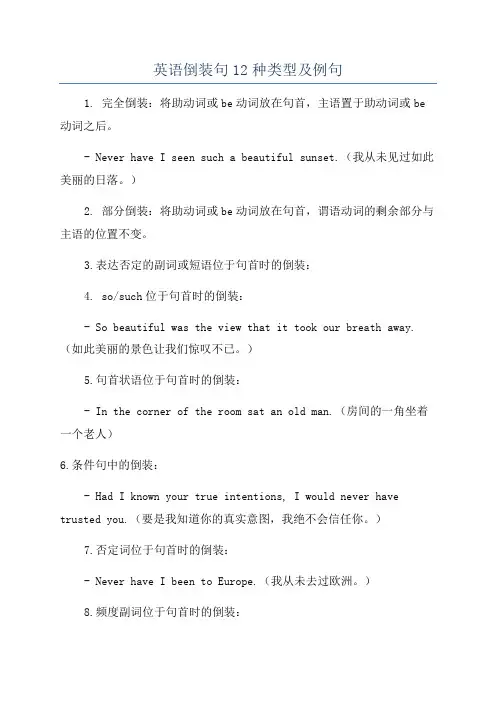
英语倒装句12种类型及例句1. 完全倒装:将助动词或be动词放在句首,主语置于助动词或be 动词之后。
- Never have I seen such a beautiful sunset.(我从未见过如此美丽的日落。
)2. 部分倒装:将助动词或be动词放在句首,谓语动词的剩余部分与主语的位置不变。
3.表达否定的副词或短语位于句首时的倒装:4. so/such位于句首时的倒装:- So beautiful was the view that it took our breath away.(如此美丽的景色让我们惊叹不已。
)5.句首状语位于句首时的倒装:- In the corner of the room sat an old man.(房间的一角坐着一个老人)6.条件句中的倒装:- Had I known your true intentions, I would never have trusted you.(要是我知道你的真实意图,我绝不会信任你。
)7.否定词位于句首时的倒装:- Never have I been to Europe.(我从未去过欧洲。
)8.频度副词位于句首时的倒装:- Rarely do we see such dedication.(我们很少见到如此的奉献精神。
)9.祈使句或祈使句部分的倒装:- Stand up!(站起来!)- Be quiet, please.(请安静。
)10. only位于句首时的倒装:- Only by working hard can you achieve your goals.(只有通过努力工作,你才能实现目标。
)11.地点状语置于句首时的倒装:- In the garden were beautiful flowers.(花园里有美丽的花朵。
)12.宾语置于句首时的倒装:- A love like this I have never felt before.(我之前从未感受过如此的爱。
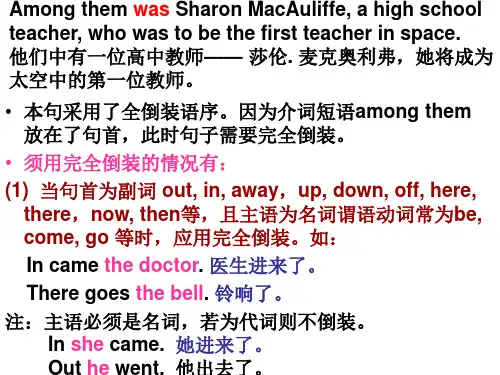
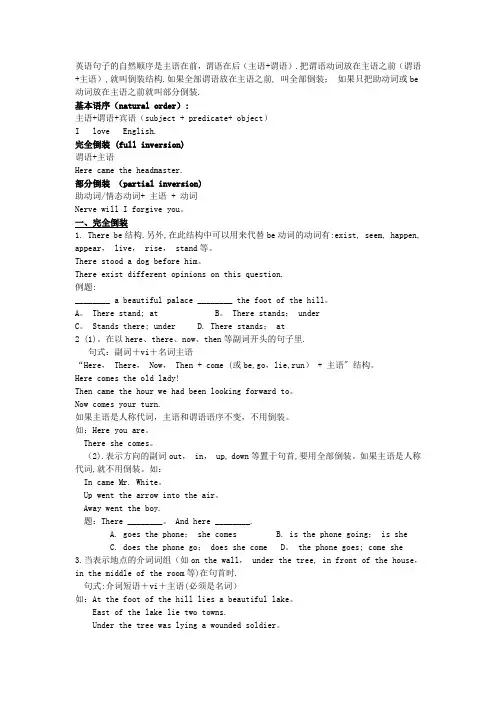
英语句子的自然顺序是主语在前,谓语在后(主语+谓语).把谓语动词放在主语之前(谓语+主语),就叫倒装结构.如果全部谓语放在主语之前, 叫全部倒装;如果只把助动词或be 动词放在主语之前就叫部分倒装.基本语序(natural order):主语+谓语+宾语(subject + predicate+ object)I love English.完全倒装 (full inversion)谓语+主语Here came the headmaster.部分倒装(partial inversion)助动词/情态动词+ 主语 + 动词Nerve will I forgive you。
一、完全倒装1. There be结构.另外,在此结构中可以用来代替be动词的动词有:exist, seem, happen, appear, live, rise, stand等。
There stood a dog before him。
There exist different opinions on this question.例题:________ a beautiful palace ________ the foot of the hill。
A。
There stand; at B。
There stands; underC。
Stands there; under D. There stands; at2 (1)。
在以here、there、now、then等副词开头的句子里.句式:副词+vi+名词主语“Here, There, Now, Then + come (或be,go,lie,run) + 主语" 结构。
Here comes the old lady!Then came the hour we had been looking forward to。
Now comes your turn.如果主语是人称代词,主语和谓语语序不变,不用倒装。
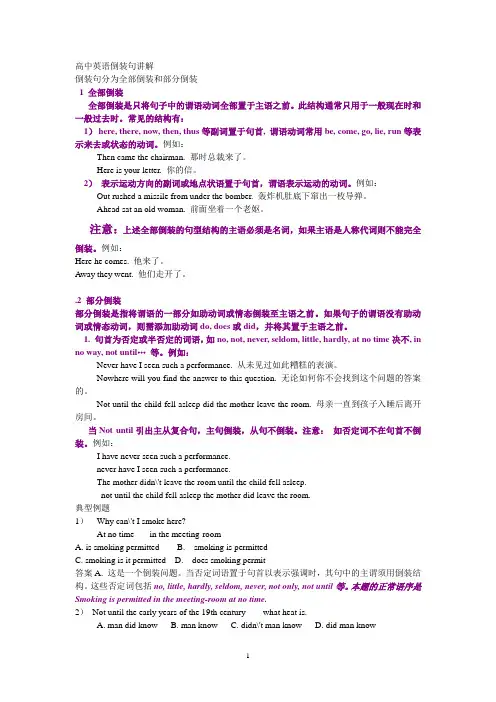
高中英语倒装句讲解倒装句分为全部倒装和部分倒装1 全部倒装全部倒装是只将句子中的谓语动词全部置于主语之前。
此结构通常只用于一般现在时和一般过去时。
常见的结构有:1)here, there, now, then, thus等副词置于句首, 谓语动词常用be, come, go, lie, run等表示来去或状态的动词。
例如:Then came the chairman. 那时总裁来了。
Here is your letter. 你的信。
2)表示运动方向的副词或地点状语置于句首,谓语表示运动的动词。
例如:Out rushed a missile from under the bomber. 轰炸机肚底下窜出一枚导弹。
Ahead sat an old woman. 前面坐着一个老妪。
注意:上述全部倒装的句型结构的主语必须是名词,如果主语是人称代词则不能完全倒装。
例如:Here he comes. 他来了。
Away they went. 他们走开了。
.2 部分倒装部分倒装是指将谓语的一部分如助动词或情态倒装至主语之前。
如果句子的谓语没有助动词或情态动词,则需添加助动词do, does或did,并将其置于主语之前。
1. 句首为否定或半否定的词语,如no, not, never, seldom, little, hardly, at no time决不, in no way, not until…等。
例如:Never have I seen such a performance. 从未见过如此糟糕的表演。
Nowhere will you find the answer to this question. 无论如何你不会找到这个问题的答案的。
Not until the child fell asleep did the mother leave the room. 母亲一直到孩子入睡后离开房间。
当Not until引出主从复合句,主句倒装,从句不倒装。
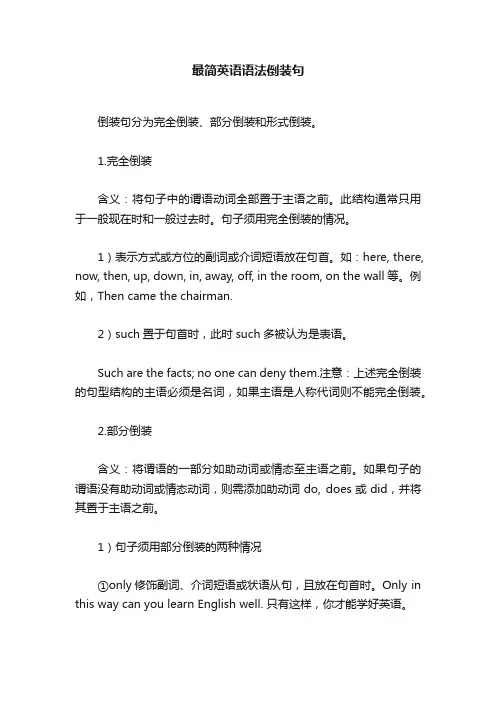
最简英语语法倒装句倒装句分为完全倒装、部分倒装和形式倒装。
1.完全倒装含义:将句子中的谓语动词全部置于主语之前。
此结构通常只用于一般现在时和一般过去时。
句子须用完全倒装的情况。
1)表示方式或方位的副词或介词短语放在句首。
如:here, there, now, then, up, down, in, away, off, in the room, on the wall等。
例如,Then came the chairman.2)such置于句首时,此时such多被认为是表语。
Such are the facts; no one can deny them.注意:上述完全倒装的句型结构的主语必须是名词,如果主语是人称代词则不能完全倒装。
2.部分倒装含义:将谓语的一部分如助动词或情态至主语之前。
如果句子的谓语没有助动词或情态动词,则需添加助动词do, does或did,并将其置于主语之前。
1)句子须用部分倒装的两种情况①only修饰副词、介词短语或状语从句,且放在句首时。
Only in this way can you learn English well. 只有这样,你才能学好英语。
②句首为否定或半否定的词语,如no, not, never, seldom, little, hardly, at no time, in no way, not until… 等。
Nowhere will you find the answer to this question. 无论如何你不会找到这个问题的答案的。
2)使用部分倒装的七个重要句型① so+ 助动词/情态动词/be + 主语:表示主语也是如此。
Tom can speak French. So can Jack. 汤姆会讲法语,杰克也会。
注意:so+ 主语+助动词/情态动词/be:表示主语确实如此。
②neither, nor + 助动词/情态动词/be +主语:表示主语也不这样。
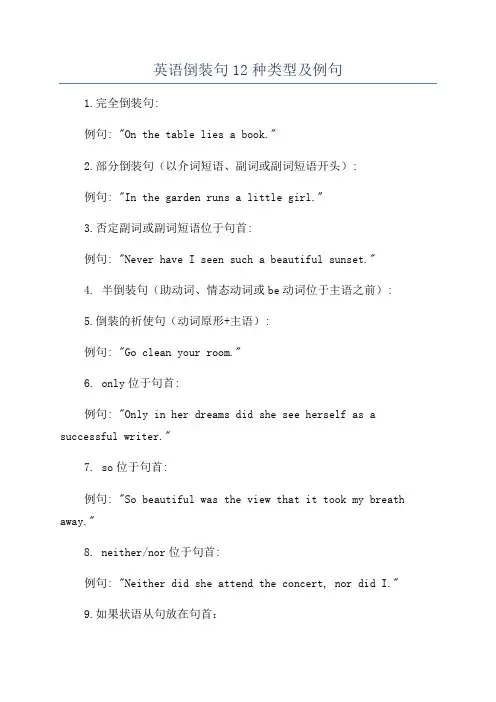
英语倒装句12种类型及例句1.完全倒装句:例句: "On the table lies a book."2.部分倒装句(以介词短语、副词或副词短语开头):例句: "In the garden runs a little girl."3.否定副词或副词短语位于句首:例句: "Never have I seen such a beautiful sunset."4. 半倒装句(助动词、情态动词或be动词位于主语之前):5.倒装的祈使句(动词原形+主语):例句: "Go clean your room."6. only位于句首:例句: "Only in her dreams did she see herself as a successful writer."7. so位于句首:例句: "So beautiful was the view that it took my breath away."8. neither/nor位于句首:例句: "Neither did she attend the concert, nor did I."9.如果状语从句放在句首:10.条件从句位于句首:例句: "Should he fail the exam, he will have to retake the course."11.介词短语或副词短语位于句首:例句: "In the corner sat a small dog."12. or/ nor引导的短语或句子位于句首:。
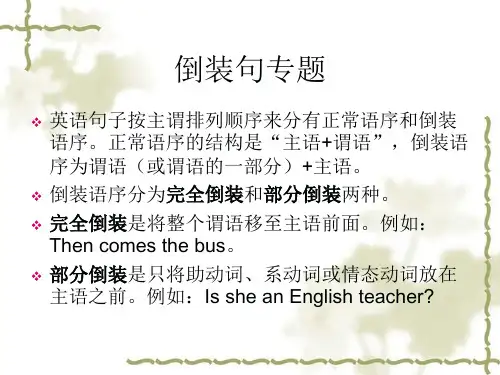

倒装句详解概念:用以表示一定句子结构的需要和强调某一句子成分的需要,分为完全倒装和部分倒装。
一.完全倒装:句子中的谓语动词全部置于主语之前.此结构通常只用与一般现在时和一般过去时。
1.以here, there, now, then等副词或 out, in, up, down, away等表示运动方向的副词或地点状语置于句首以示强调,句子要全部倒装, 谓语动词常用come,go, be, lie,run,rush等.2. 表示地点的介词短语位于句首时A beautiful lake lies at the foot of the hillAt the foot of the hill lies a beautiful lake。
注意:在上述句子中, 如果主语为人称代词, 则主、谓不需要倒装。
In he came and back he went again.Away he went .二.部分倒装:be/助动词/情态动词提前到主语的前面.Is am are was were(be动词)do does did(助动词) can could would may will might(情态动词)等1。
only所修饰的副词、介词短语或状语从句放在句首时,要进行部分倒装.Only then did I realize the importance of learning English.Only after he came back was I able to see him。
注:only修饰主语,仍用自然语序,如:Only socialism can save China.I seldom go to the cinema。
倒装:Seldom do I go to the cinema.我很少去看电影.I have never seen such a performance。
倒装:Never have I seen such a performance。
语法精讲:英语倒装句总结倒装的种类英语最基本的词序是主语在谓语动词的前面。
如果将句子的主语和谓语完全颠倒过来,这称之为完全倒装。
如果只将助动词或情态动词移至主语之前,谓语的其他部分仍保留在主语的后面,这称之为部分倒装。
一.完全倒装完全倒装是将谓语的全部放在主语之前,此结构通常只用于一般现在时和一般过去时两种。
On her left sat her husband.她左边坐着她丈夫。
Here is the book you want.你要的书在这儿。
Down went the small boat.小船沉下去了。
二.部分倒装部分倒装是指将谓语的一部分,如助动词或情态动词,移至主语之前。
Only by working hard can one succeed.只有努力才能成功。
Never have I seen her before.我以前没见过她。
提示:如果句中的谓语没有助动词或情态动词,则需添加助动词do,does或did,并将其置于主语之前。
Well do I remember the day I joined the League.入团的那一天,我记忆犹新。
Little did I think that he could be back alive.我没有想到他竟能活着回来。
三.常见的倒装结构A.常见的完全倒装结构1.there be句型。
There is a mobile phone and some books on the desk.桌上有一个手机和一些书。
There are thousands of people gathering on the square.广场上聚集着成千上万的人。
注意:引导词there还可以接appear,exist,lie,remain,seem,stand,live等词。
There lived an old fisherman in the village.村里住着一位老渔夫。
英语倒装句的四种基本句型例句嗨,小伙伴们!今天咱们来好好唠唠英语倒装句的四种基本句型,这可真是英语学习里超有趣的一部分呢。
就像一场奇妙的语言魔术,让句子变得超级有特色。
**一、完全倒装(Full Inversion)**完全倒装就是把整个谓语动词都放到主语之前啦。
这就好比是把一场演出的主角(主语)和配角(谓语)的出场顺序完全颠倒了一下,给人一种很新奇的感觉。
例句1:There goes the bell.(铃响了。
)你看,正常的语序应该是The bell goes there. 但是这样一倒装,就有一种突然性,就像你正等着什么事情发生,然后“铃就响了”,这种表达更加生动。
我还记得我刚学这个的时候,我同学问我:“为啥要这么说呀?直接说The bell goes there不就得了?”我就跟他说:“哎呀,这就像你去看魔术表演,魔术师要是按平常的方式出牌,那还有啥惊喜呢?这种倒装句就像魔术里的大变活人,突然把主语和谓语的位置变了,让句子变得超酷。
”例句2:Here comes the bus.(公共汽车来了。
)想象一下,你在车站等车等得心急火燎的,然后你大喊一声“Here comes the bus”,是不是感觉比“The bus comes here”更带感呢?这时候句子就像是一个充满活力的小助手,快速地把重要的信息“bus来了”传达给你。
例句3:Away flew the birds.(鸟儿飞走了。
)这个句子要是正常说就是The birds flew away. 可一旦倒装,就像是我们在描述一个很突然的画面,鸟儿“嗖”的一下就飞走了,那种动态感更强了。
我跟我的英语老师讨论这个句子的时候,老师说:“你看,这种倒装就像是给句子加了个加速器,让动作更迅速地呈现在读者或者听者的脑海里。
”我当时就觉得,哇塞,真的是这样呢!**二、部分倒装(Partial Inversion)**部分倒装呢,就是只把助动词、情态动词或者be动词放到主语前面,主要动词还在主语后面呢。
英语句子的自然顺序是主语在前,谓语在后(主语+谓语)。
把谓语动词放在主语之前(谓语+主语),就叫倒装结构。
如果全部谓语放在主语之前, 叫全部倒装; 如果只把助动词或be 动词放在主语之前就叫部分倒装。
基本语序(natural order):主语+谓语+宾语(subject + predicate+ object)I love English.完全倒装 (full inversion)谓语+主语Here came the headmaster.部分倒装 (partial inversion)助动词/情态动词+ 主语 + 动词Nerve will I forgive you.一、完全倒装1. There be结构。
另外,在此结构中可以用来代替be动词的动词有:exist, seem, happen, appear, live, rise, stand等。
There stood a dog before him.There exist different opinions on this question.例题:________ a beautiful palace ________ the foot of the hill.A. There stand; atB. There stands; underC. Stands there; underD. There stands; at2 (1).在以here、there、now、then等副词开头的句子里。
句式:副词+vi+名词主语“Here, There, Now, Then + come (或be,go,lie,run) + 主语" 结构。
Here comes the old lady!Then came the hour we had been looking forward to.Now comes your turn.如果主语是人称代词,主语和谓语语序不变,不用倒装。
如:Here you are.There she comes.(2).表示方向的副词out, in, up, down等置于句首,要用全部倒装。
如果主语是人称代词,就不用倒装。
如:In came Mr. White.Up went the arrow into the air.Away went the boy.题:There ________. And here ________.A. goes the phone; she comesB. is the phone going; is sheC. does the phone go; does she comeD. the phone goes; come she3.当表示地点的介词词组(如on the wall, under the tree, in front of the house, in the middle of the room等)在句首时。
句式:介词短语+vi+主语(必须是名词)如:At the foot of the hill lies a beautiful lake.East of the lake lie two towns.Under the tree was lying a wounded soldier.注意:在上述句子中,如果主语为人称代词,则主、谓不需要倒装。
In he came and back he went again.4."分词(代词) + be + 主语"结构。
Walking at the head of the line was our teacher.Such was the story he told me.题:________, a man of achievements, deep thoughts, but with simple habits.A. Einstein was suchB. Such was EinsteinC. Einstein was soD. So was Einstein________ are the days when teachers were looked down upon.A. GoneB. GoC. To goD. Going5,某些表语位于句首,保持句子平衡,以强调表语. 句式:表语+系动词+主语(必须是名词)1)表语为介词短语Among the goods are Christmas trees, flowers, candles and toys.2)表语为形容词Present at the meeting were Mr White and many other guests.3)表语为过去分词Seated on the ground are a group of young people.4)表语为进行时态中的现在分词Lying on the floor was a boy.Standing beside the desk was a teacher.二、部分倒装部分倒装是把be动词、情态动词、助动词放到主语之前。
如果句子中没有这些词,要在主语之前加助动词do / does / did等,而把原来的谓语动词变成原形放在主语之后。
1. 句首状语为否定词或半否定词的句子。
这类词或短语主要有never, neither, nor, little, seldom(很少,不常), rarely(很少,罕有), hardly, scarcely(几乎不,简直没有), no sooner(立即), by no means (决不),not only, in no way(决不), at no time, few, not, no等,句式:“否定词/词组+助动词/情态动词/be动词+主语+其他”。
Not until+从句/时间状语+主句(部分倒装)。
No sooner had sb done than…;Hardly/scarcely had sb done when…刚刚…就Not only+分句(部分倒装)but also+分句(不倒装)注意:①not only置于句首②but(also)部分不倒装,1) Hardly ____ the airport when the plane took off.A. I had arrived atB. had I arrivedC. had I reachedD. I had got to2) —Have you ever seen anything like that before?—No, _____ anything like that before.A. I never have seenB. never I have seenC. never have I seenD. I have seen3) She is not fond of cooking, ____ I.A. so amB. nor amC. neitherD. nor do2. Only + 状语(副词/ 介词短语/ 状语从句),位于句首 ,要部分倒装。
Only by this means is it possible to explain it. (介词短语)Only then did I realize the importance of math. (副词)Only when the war was over in 1918 was he able to get happily back to work. (从句)注意:①在only+状语从句+主句结构中,主句倒装,但从句用正常语序。
②only修饰主语,不倒装。
3. so或so引导的短语放在句首,前半部分倒装。
I saw the film, so did she.So loudly did he speak that even people in the next room could hear him.1) The doctor told Charlie to breathe deeply and ____.A. so did CharlieB. Charlie did soC. Charlie does soD. did Charlie so2) So loudly _____ that ____ hear her clearly.A. did she speak; could everyoneB. did she speak; everyone couldC. she spoke; could everyoneD. she spoke; everyone could4. "Not only + 分句,but also + 分句"句型中的前一分句要部分倒装。
但not only...but also...连接主语时,不倒装。
如: Not only the mother but also the children are sick.如: ___ himself wrong, but his friends were wrong.A. Not was only heB. Not only heC. Not only was heD. Not only was5、as/ though (虽然,尽管)引导的让步状语从句。
句式:名词\形容词\副词\动词\分词+as\though+主语+其他如:Although I am ugly, I am gentle.Ugly as I am, I am gentle.Though he is a child, he has to make a living.Child as he is, he has to make a living.注意:从句的表语是名词,其名词前不加任何冠词6.用于So/neither (nor) + be ( have, 助动词或情态动词) + 主语+其他的句子表示两人的同样一个情况时,只能表示一件事,即上、下句所使用的动词、时态要一致。
否则要用so it is with…/It is the same with…He has been to Beijing. So have I.Tom can’t answer the question. Neither /Nor can I .So +be/助动词/情态动词+主语某人也是如此Nor/neither +be/助动词/情态动词+主语某人也不是如此So +主语+be/助动词/情态动词某人确实如此如:I have never been to Guangzhou University, neither/ nor has he.我从来没有去过广州大学,他也是.7.在虚拟语气条件句中从句谓语动词有were, had, should等词,可将if 省略,把 were, had, should 移到主语之前,采取部分倒装。